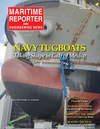
Page 18: of Maritime Reporter Magazine (November 2024)
Read this page in Pdf, Flash or Html5 edition of November 2024 Maritime Reporter Magazine
The Path To Zero
As a fuel, hydrogen produces neither carbon nor local emis- electri? cation projects, it can be expensive and time-consuming sions. It can be combusted in an engine to produce mechani- to get the necessary charging infrastructure permitted and built. cal power or chemically reacted with oxygen in fuel cells to The power required for rapid shoreside charging puts a strain on produce electricity. Fuel cells can be used to power electric the grid and batteries are often a necessary addition to charging ships, but some ef? ciency losses must be accounted for in infrastructure to minimize peak loads. Harbor vessels and ferries the electrical conversion. Like many emerging technologies, operating in areas that cannot support shoreside charging could fuel cells present challenges associated with cost, scale, and bene? t from hydrogen fuel as an alternative to electri? cation.
regulatory maturity, but are quieter and more ef? cient than a The marine industry is not alone in the need for clean fuels or combustion engine. green hydrogen. Other industries considered hard to abate, such
Hydrogen has low energy density compared to other fuels, but as aviation, steel production, and agriculture, could become large is an attractive option for the right application. Hydrogen can be consumers of green hydrogen as both a fuel and a feedstock for stored as a compressed gas or as a liquid; liquid hydrogen is a various low-carbon fuels or chemicals. The aggregate demand cryogenic fuel and more energy dense than compressed hydrogen, for green hydrogen will help to drive the costs down as well as but it is harder to make, more challenging to handle, and requires the required infrastructure needed for production and distribu- special equipment to store and vaporize before use. Compressed tion. Production will require massive amounts of carbon-free hydrogen is less energy dense but easier to produce and simpler electricity such as wind, solar, geothermal, and nuclear power, to store and use. For short-range applications where battery-elec- as well as new facilities for fuel production. New infrastructure tric is not feasible, hydrogen may be an excellent fuel choice. will be needed for transport and storage, which could bene? t the
Battery-electric has become an increasingly popular method of marine industry. For example, specialized tankers will be need- converting ferries and other harbor craft to zero emissions, but ed to transport the fuels from where they are produced to where requires access to shore power for charging. For many marine they will be consumed, and ports will need ways to store and transfer clean fuels so ships can be bunkered for long voyages.
Moving the needle for marine decarbonization and the pro- duction of green fuels will require domestic and global action.
COP 28 saw landmark agreements to scale up renewable energy, phase out fossil fuel subsidies, ramp up clean hydrogen produc- tion, and increase energy ef? ciency. The Green Shipping Chal- lenge, co-led by the US and Norway, spurred COP 28 announce- ments around actions to increase use of low- and zero-carbon fuels. The process of shifting industry away from a reliance on fossil fuels is well underway. Already we are seeing initiatives to prepare the supply chain for clean fuel and the development of new and existing technologies required to achieve decarbon- ization targets. Regardless of whether hydrogen emerges as the fuel of the future, all low- or zero-carbon fuels depend on its abundance and availability. The chemical energy in all potential marine fuels—whether diesel, methanol, methane, ammonia, or even pure hydrogen—comes from the rearrangement of hydro- gen atoms during chemical reactions in combustion engines or fuel cells. New technologies will be required to reach our lofty decarbonization targets, but the energy transition will only be possible through a massive scaling up of production and green fuels, renewable and clean energy, and a lot of hydrogen.
The Author
Caughlan
Sean Caughlan is a principal marine engineer at Glosten. Sean is one of the industry’s leading experts on the design of alternative-fueled, battery-hybrid, and all electric powered vessels including ferries, tugs, Ro-Ro ships, and research vessels.
18 Maritime Reporter & Engineering News • November 2024
MR #11 (18-33).indd 18 10/24/2024 11:44:39 AM

 17
17

 19
19
